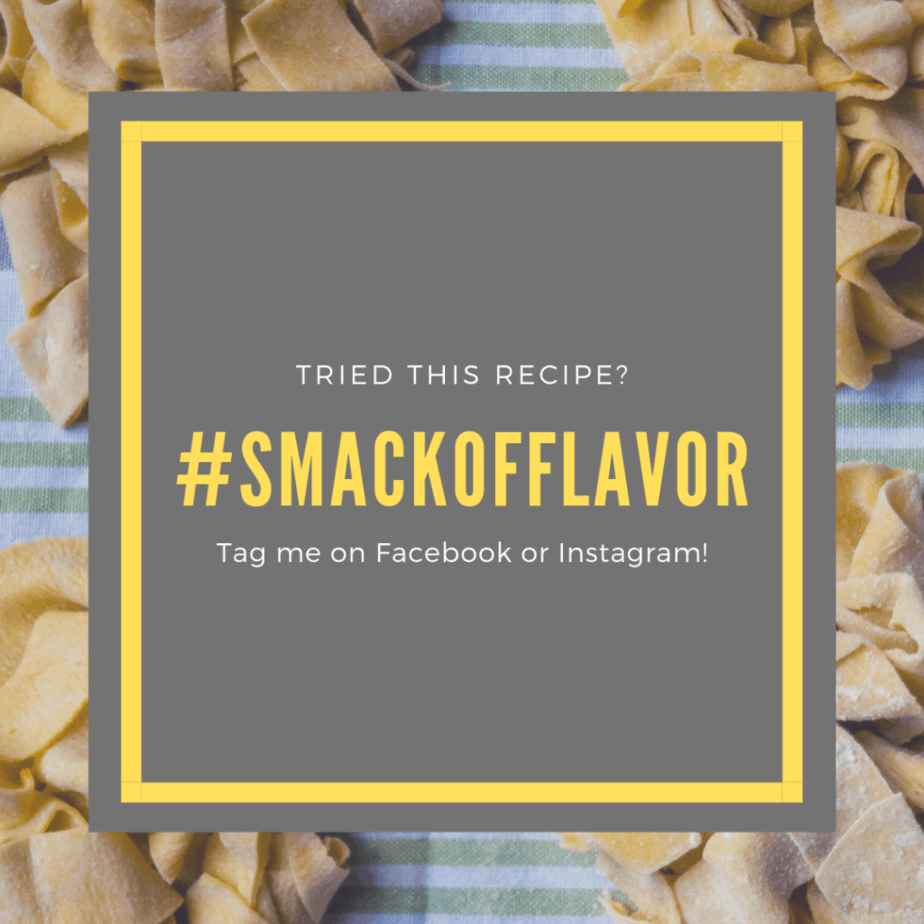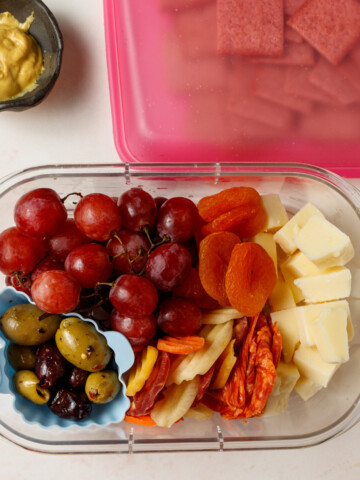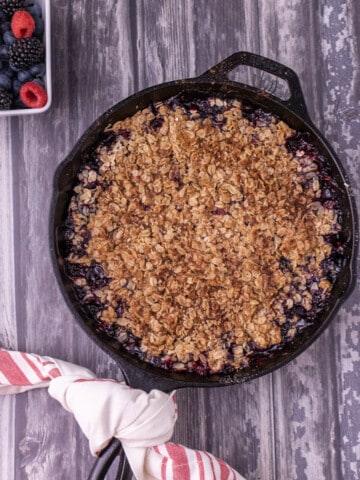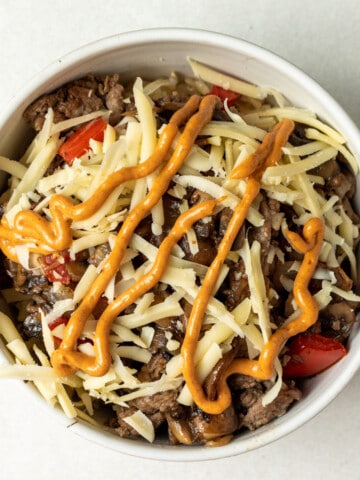

Tips, Tricks and Substitutions
Can you use bacon? You can definitely use bacon, pancetta or guanciale for this recipe. I prefer pancetta because it’s easier to find than guanciale and has a more complex flavor than most of the bacon readily available at the grocery store.
Are parmigiano reggiano and parmesan the same type of cheese? Yes and no. Parmigiano reggiano is produced in a very specific region of Italy under very strict conditions. This means that you know exactly the quality you are going to get. Parmesan cheese can vary between brands and countries as it is less regulated. Parmesan is an imitation of parmigiano reggiano and usually cheaper. However, because this cheese plays such a prominent role in the dish, it is important to get the good stuff and splurge a little bit.The pre-shredded cheese may not melt as well and will compromise the taste and texture of the final dish.
Ingredients
What is the difference between parmigiano reggiano and pecorino romano? Both cheeses are hard and salty Italian cheeses that are easy to grate.A big basic difference is in the type of milk used. Pecorino is a sheep’s milk cheese which gives tangier and saltier cheese. Parmigiano is made from cow’s milk resulting in a nuttier and more mild cheese. I love to combine the two to give a good mixture of the two flavors.
Do you need to use both types of cheese? If you prefer one over the other, by all means, just use that one. Or if you’re in a pinch you can use whatever one you have, it’ll still taste good. Using one or both of these specific two types of cheese is recommended. I would NOT deviate from the types of cheese, but they should be easy enough to find in the grocery store.
Is the rind edible on the cheeses? Yes, you can eat them but they tend to be a bit waxy. I like to save mine and store them in the freezer. I then add them to sauces and soups for an umami and cheese boost.
What kind of pasta it the best type of pasta to use? I like to use rigatoni (giant tubes) because I find that it holds the sauce really well. I prefer pasta that has an increased surface area (elbows, rotini etc) to really soak up the sauce. Again, if you’re a pinch, use whatever pasta you have on hand. I’m not a fan of spaghetti, but a lot of people like pasta carbonara with that it.
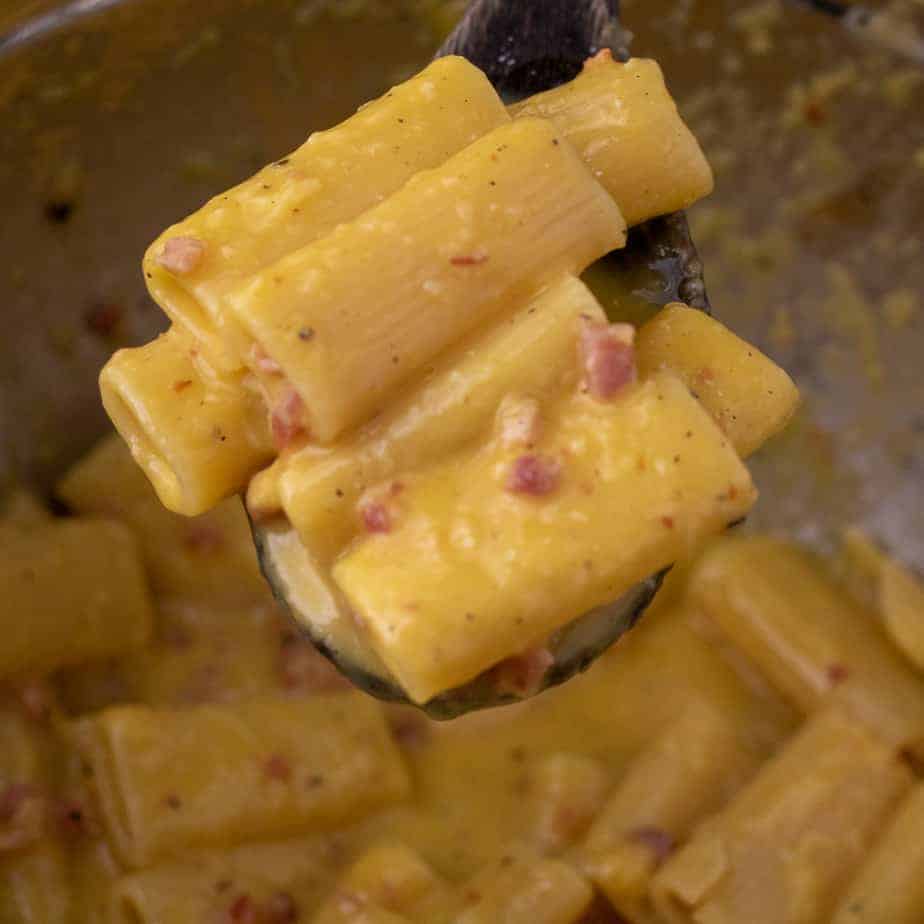
Method
How do you separate an egg yolk? I like to start with two separate small bowls. One bowl I use as “trash” (the egg whites and shells) and the other one is for the egg yolks. To separate the eggs I crack the egg on a flat surface (the edge of a bowl can drive egg shells into the center. Fishing out egg shells is a pain) and then over the trash bowl I transfer the yolk to one side of the shell, allowing the egg white to drip into trash bowl. I then transfer the yolk to my hand and allow the rest of the egg white to drip into the trash bowl. Once the egg yolk is separated, I add it into the designated egg yolk bowl and continue until I’ve done all 5 egg yolks. I then crack the final whole egg into this bowl and then transfer to the large mixing bowl with the cooled pancetta.
How do you get the eggs not to scramble? There are two ways to keep the eggs from scrambling. The first way is never having the eggs over heat. The other way to avoid scrambling the eggs is by adding a little pasta water directly into the egg and mixing immediately. Then you can add the pasta directly into the egg mixture and stir immediately. It is important that you stir immediately to help temper the eggs. If you let the pasta sit on the eggs for took long they may slightly scramble.
Is pasta water really that necessary? Yes! Absolutely! Pasta water helps emulsify the sauce which gives you the creamy taste without any cream. Traditionally, pasta carbonara doesn’t have any cream or butter, just eggs, cheese and pasta water to create the sauce. I always grab a full cup of the pasta water using a glass measuring cup before the pasta is strained. That way I don’t forget to save it. Pasta water is the secret to a creamy sauce in a lot of dishes. You don’t need a lot but just enough to thicken and bind the sauce.
You May Also Like

Pasta Carbonara
Ingredients
- 2 oz shredded parmigiano reggiano about ¾ cup, plus more for garnish
- 2 oz shredded pecorino romano about ¾ cup
- 4 oz pancetta diced
- ½ pound dry pasta
- Kosher salt
- 5 egg yolks from large eggs
- 1 large egg
- 1 teaspoon freshly grated black pepper
Instructions
- Freshly shred both cheeses and mix in a small bowl. Set this bowl aside.
- Add the pancetta to a medium skillet. Turn the heat to medium and allow the fat to render for 6-8 minutes. The pancetta will be done when it just slightly begin to crisp and most of the fat is rendered. Transfer the fat and pancetta to a large mixing bowl to cool slightly.
- While the pancetta is cooking in skillet, begin boiling water. Be sure to salt your pasta water until it tastes just salty. Add the pasta to boiling water once the pancetta is finished cooking. Cook the pasta until al dente according to the instructions.
- While the pasta is cooking, in a separate bowl, separate 5 egg yolks and add one large egg. I do this using two separate bowls to avoid any eggshells in the egg mixture. Add the egg mixture to the pancetta in the large mixing bowl. Whisk until combined.
- Before you drain the pasta, reserve about 1 cup of pasta water.
- . Once the pasta is done, add about 2 tablespoons of the pasta water directly into the egg mixture and whisk immediately. Now, workingly quickly, drain the pasta and add it directly into the large mixing bowl containing the eggs and pancetta. Stir to coat immediately to avoid scrambling the eggs.
- Add 2 more tablespoons of the pasta water to the pasta mixture with ½ of the cheese. Stir until the cheese is melted. Add in the rest of the cheese and continue to stir until all the cheese is melted. If the sauce is a little thick, add pasta water by the tablespoon until it is a creamy texture.
- Finally by adding the black pepper and taste the pasta. Both the cheeses are salty and the pasta water are a bit salty, so taste it before you add more salt.
- Dish out the pasta and top with a little bit more cheese as a garnish.
Notes and Accommodations
- Be sure to save pasta water before draining the pasta. I use a glass measure cup to scoop it out of the pot right before the pasta finishes cooking.
- To avoid scrambling the eggs, mix the pasta in with the egg and stir immediately. This will help you temper the eggs.
- Add the cheese in batches to make sure it all melts before you add more to ensure the sauce is velvety.
